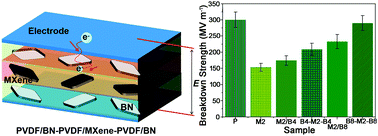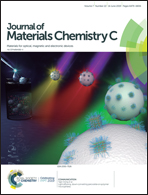High dielectric and breakdown properties obtained in a PVDF based nanocomposite with sandwich structure at high temperature via all-2D design†
Abstract
A high relative permittivity and breakdown strength are important to the high energy storage of dielectrics. However, in homogeneous composites, electric tree growth leads to premature breakdown. The thermal breakdown of a polymer matrix from excessive heat accumulation results in a low breakdown strength of the composites. In this work, polymer/2D MXene/2D BN nanocomposites were fabricated in a sandwich construction. Ti3C2 nanosheets with a high electric conductivity and stiffness, as well as hexagonal BN (h-BN) nanosheets with an ultrahigh thermal conductivity and breakdown strength, were employed as fillers. Polyvinylidene fluoride (PVDF) was used as the matrix. A mild interface polarization between MXene and PVDF endows the composite with the desirable dielectric properties. Charge injection from the electrodes can be depressed owing to BN in two outer sub-layers, and electric tree growth across the thickness can be impeded due to the interface barrier effect between two adjacent sub-layers. A high breakdown property was obtained. An acceptable temperature-dependence of relative permittivity and breakdown strength was gained and is ascribed to heat evacuation from MXene and BN. The inhomogeneous composite is superior to the homogeneous counterpart. The optimized sandwich composite has a breakdown strength of 235 MV m−1 and relative permittivity of 24@1 kHz at 140 °C. This work might open up the way for the large-scale preparation of promising composite dielectrics.



 Please wait while we load your content...
Please wait while we load your content...